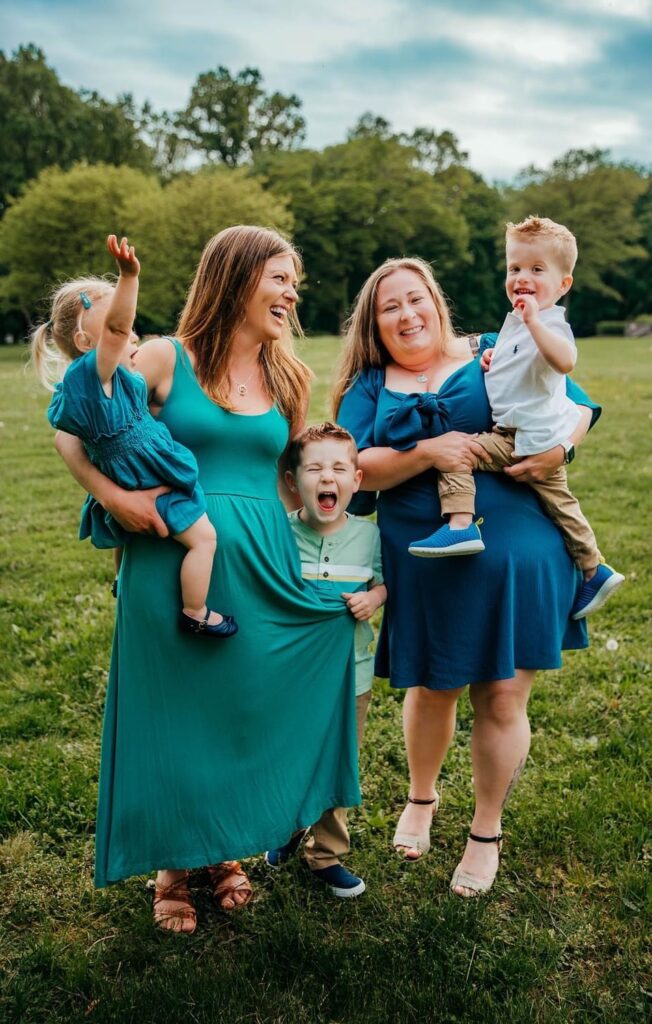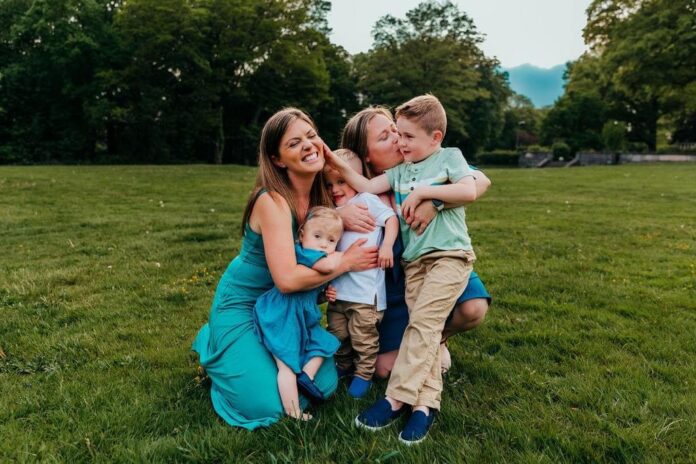Pride Month is upon us. For some, that means donning rainbows and spending a sunny, summer Sunday congregating in the Gayborhood. For others, it might mean recommitting their investment to an LGBTQ+ cause or organization through donations or volunteer hours. For still others, Pride may be a time to reflect on their role in the community or an opportunity to take their first step into that community.
For LGBTQ+ parents, their perspectives on Pride may seem somewhat divergent: a look back at their own journey into their identity, as well as an exploration of how it influences—and will continue to influence—their kids’ lives. Ashlee and I have yet to take our kids to a Pride event. That’s in large part because taking three kids 5 and under anywhere outside our neighborhood can be downright torturous. As the kids get older, we want to be more intentional about introducing them to the wider community that shaped their parents’ history so much, but we’ve been fortunate to have not yet felt like we needed Pride for them. We are thankfully surrounded by accepting, inclusive family, friends, neighbors and more—our own little community in which our identity as an LGBTQ-headed family is just par for the course.
Having the opportunity to raise these kids in an environment where having two moms isn’t a big deal has allowed us to view that aspect of our identities through a different lens—that of a child, one whose worldview is just starting to come together. That’s given us a fascinating look into their world, how they see ours and the potential that brings.

Acceptance is innate
Obviously, our kids didn’t have a choice: They had to accept their two moms! But the way in which they began the process of understanding our family in relation to others has shown us that acceptance isn’t a choice; it can be automatic, if you’re given the right tools.
August and Avery are getting to the age where they’re starting to draw comparisons between us and what they see in books and on television of what a typical family is—by and large, a mom, dad and kids. Sure, we have a range of LGBTQ-inclusive kids’ books and were just as stoked as the next family when a character on “Bluey” casually mentioned his two moms, but the reality is that the vast majority of the families they will encounter outside of ours—both real and fictional—aren’t LGBTQ-identifying. Wherever we can, we try to help them understand those families in the context of ours—and our family in the context of those others.
The intro song for “Peppa Pig,” for instance, starts with the parents introducing themselves: “Mom! Dad!” and that may prompt us to say to the twins, “Look, they have a mom and a dad, just like we have a mom and a mommy.” Or when reading a book, we may point out, “That little boy lives with his grandma. Your grandparents would love to have you around all the time!” As best we can, we’re trying to illustrate that truly no two families look exactly the same. When kids are given that lesson early—and see it play out in their own lives—it just makes sense to them: Families are different, no big deal.
That’s not to say it will always be easy for them to accept these differences; I’m certain they will encounter viewpoints throughout their lives that may have them questioning just how valuable diversity is, when faced with bullying or mistreatment. But I’m hoping that as much as we can lay a strong foundation for acceptance now, they will have that to ground them in the future.
It doesn’t have to be complicated
“I don’t have a dad; I have a mom and a mommy.”
I’ve heard Jackson explain this so many times to kids his age and, each time I hear the conversation creep in this direction, my pulse quickens, terrified some snot-nosed kid is going to make him feel bad and I’ll have to throw down with the parents. But never once has this conversation (at least in our earshot) gone sideways. It’s usually met with “Oh, cool.” One kid on our block is actually so enthused that Jackson gets to have two moms (because moms are the best, right?!) that he brings it up at home all the time, his mom tells us.

Have confidence in yourself—and others will too
As much as most kids take the two-mom news lightly, adults often have a harder time being nonchalant. While folks likely are completely accepting, most probably have to break through decades of having seen little LGBTQ+ visibility, making an actual LGBTQ+ family seem like an anomaly. For instance, the daycare teachers who whispered to us in the hallway about if Jackson has a grandad he could make a Father’s Day gift for, or the NICU staff stumbling over which one of us is called “Mom” or “Mommy.”
We get it: They didn’t want to get things wrong and make us, and certainly not our kids, feel uncomfortable. But what these kiddos have shown us is the importance of confidence: They have two moms—no biggie, so don’t sweat it. It’s advice we may need to heed ourselves. As the kids get older, those external forces that can turn acceptance into ridicule are going to grow—and I think it will be important for us to continue to convey confidence in our family to the kids so that they, in turn, absorb and project that same level of certainty.
***
This June, I hope we all feel free to celebrate what Pride means to us. For me, it means getting to go on this parenting journey with the person I love and raise three wonderful kids who love their two moms. How much prouder could we get?
